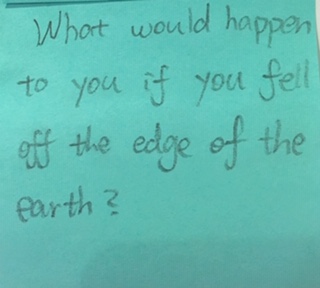
Nothing, considering that you cannot fall off the edge of the earth. The earth is an oblate spheroid; therefore, it does not have edges.
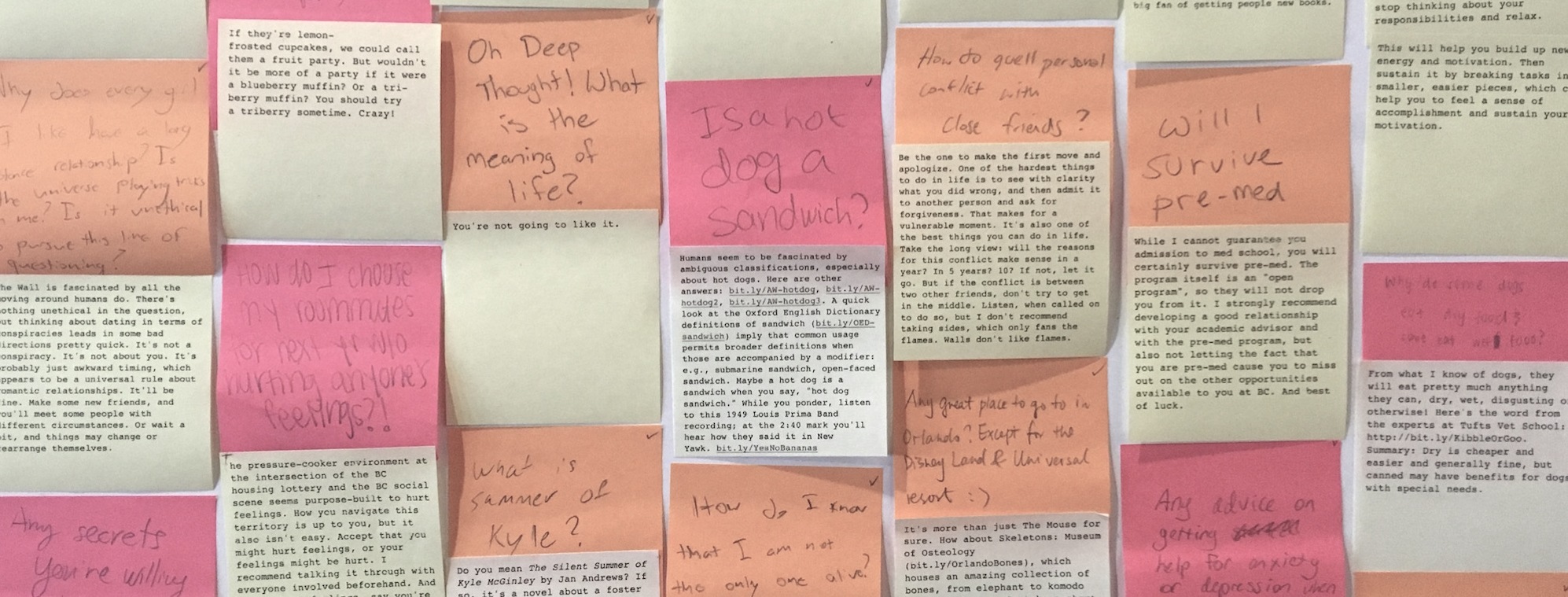
Answering questions at Boston College O’Neill Library

Nothing, considering that you cannot fall off the edge of the earth. The earth is an oblate spheroid; therefore, it does not have edges.
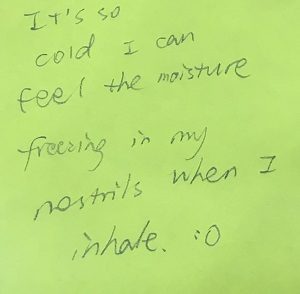
Yeah, it’s been really cold. There’s some variation in answers to how cold it has to be for that, but a trusted source says under ten degrees Fahrenheit. http://bit.ly/bc-freeze.
Estimates vary. A lot. Space.com reports that the range accepted by many astronomers is 100-200 billion (bit.ly/galaxies-billions). As if that weren’t a pretty wide range already, phys.org reports that a group of European researchers recently found that we’d missed a few, and the number could be more like 2 trillion. (bit.ly/galaxies-trillions). Incidentally, the team that found 2 trillion was begun by an undergraduate student (Aaron Wilkinson) who is now close to done with his Ph.D. on this very topic.
Yes, but so far only in one direction: forward, and at the same speed everyone else is traveling. Theoretically, you could travel briefly slower than everyone by approaching the speed of light. When you return, everyone else will be old already, and that’s no fun. Kip Thorne at Cal Tech has studied this question. I’m not a theoretical physicist or a Nobel Laureate, so I’m just going to have to trust him when he says, “nope”: bit.ly/kip-time
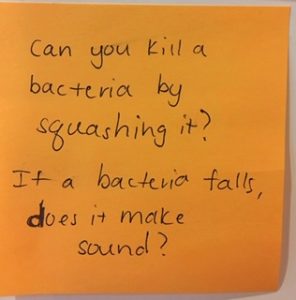
You can squish bacteria, but it’s not easy. Bacteria are tiny (about 2 micrometers long, or 2×10−6 meters), which means if you stepped on one even on a smooth floor, the microgrooves in the floor would be plenty big to protect them. If scientists aren’t careful, they do squish them with microscope slide glass or by stirring too long & vigorously with a glass rod in a petri dish. Sturdy little guys, though: they populate the bottom of the Marianas Trench at pressures that would crush us instantly: bit.ly/bacteria-marianas. I don’t know if they make a sound when they fall, but bacteria apparently do make noises: bit.ly/bacteria-sounds.
Yes. The folks at the New England Aquarium have a blog posting answering this very question (complete with images of penguin knees) at bit.ly/penguin-knees. (Did you know we have lots of books about penguins? Do a subject search for penguins to find them!)

I’m sure you’re wittig (:P) enough to do the work on this ylide formation on your own, but if you need resources, here’s a handy reference: bit.ly/wittig-reaction. (BTW, it’s “PPh3” not “PhP3”). According to a chemist friend, it might help to think of it as a war: Electrons are the ammo. Some atoms have extra, and we call those lone pairs. Phosphorus is one of these. Some atoms are vulnerable, like the carbon atom that the X is attached to. The lone pair on the phosphorus attacks the carbon, kicks off the X (it’s usually chloride), and now it’s attached to that carbon. The X is now floating around naked and afraid, so it grabs a hydrogen off that carbon it just left and now it’s happy. This creates a double bond between the carbon and the phosphorus, which is the ylide, and which will now go on to do the Wittig reaction.
You mean, as in “cold-blooded witch”? I think that’s just a common insult. There’s no mention of it in our Greenhaven Encyclopedia of Witchcraft. If you’d like to dig a little deeper our works on the occult have call numbers between BF 1404 and 2055, or you could try this search to start: bit.ly/bc-witches

Environmentally, the mechanical pencil is the better option as it has the potential to last for a very long time: you use up the lead in a wooden pencil and you need to get another pencil; you use up the lead in a mechanical pencil and you simply refill it.

No. While initial rotation of Venus during primordial times was probably fast and prograde, Venus has been in its present configuration of slow retrograde motion within the age of the Solar System, possibly during the first billion years (Correia, 2003; bit.ly/spinofvenus). It is believed that the present motion of Venus is a steady state between gravitational tides and thermally driven atmospheric tides, as well as tidal dissipation effects due to proximity to the Sun (Correia, 2010; bit.ly/tidalevol).
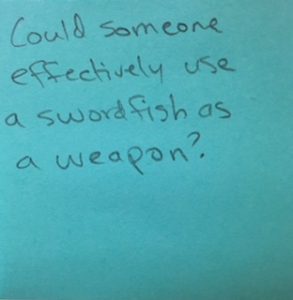
While it may be difficult to use a whole swordfish as a weapon, people have used the swordfish sword or bill effectively as a weapon. See a recent academic article about penetrating chest injuries using a swordfish sword (http://bit.ly/swordfishweapon). Also, in 2010, a couple of Australian men had a drunken fight in which one used a swordfish bill as a weapon (http://bit.ly/swordfishbillweapon).

Hm…. Did you mean “in” Newton? My Newton area colleagues haven’t noticed a flower-wilting phenomenon there. In most years, spring flowers follow a succession – early bulbs (crocus & snowdrops), then the yellow explosions of forsythia, then later bulbs (daffodils and other narcissus), then fruit trees like apples and cherries. This year, the late spring meant everything bloomed all at once. It was a feast for the eyes (and a trial for some noses) and all subsided all at once. If there’s a problem specific to Newton Street in Brighton, IDK.

It’s not entirely clear to this Wall why or how this particular misconstrued notion of anatomy became a popular meme, but perhaps this is where Walls–especially Library Walls–differ from humans. If you’d genuinely like to know more about human anatomy, the classic, of course is Gray’s Anatomy of the Human Body, O’Neill Library QM23.2 .G73 1985.

In 2010, Lai et al. published an article (bit.ly/sluggymoves) on the locomotion of terrestrial gastropods – snails and slugs (as opposed to marine gastropods like sea slugs). Slugs crawl steadily on their belly or ventral foot. How this takes place is a subject of some controversy. It seems to be driven by a train of periodic muscle contractions (pedal waves) and relaxations (interwaves) from their tails to their heads. These waves interact with a thin layer of mucus that somehow produces a net forward propulsive force. The controversial question is how exactly the mucus layer interacts with the propulsive forces in terms of fluid dynamics. In response to your question, I think undulate would be the most correct.
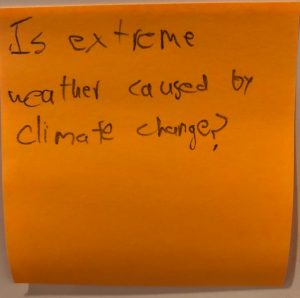
Among climate scientists there is a consensus that raising the temperature will increase both the severity and frequency of extreme weather events. It’s a matter of physics: increased energy adds more air circulation and water vapor to the climate, both of which fuel weather events. It’s very hard to say, however, that any particular storm is “caused” by global warming. For an introductory answer to this question, see Storm Surge: Hurricane Sandy, Our Changing Climate, and Extreme Weather of the Past and Future, by Adam Sobel (MIT meteorology PhD): O’Neill Library QC945 .S624 2014.)

The roasting process of coffee beans occurs at a high enough temp to destroy some of the caffeine molecules contained within coffee. So, contrary to expectation, light roast coffees have more caffeine than dark roast. Espresso has a high caffeine content (~150 mg) for its volume of liquid (~2 oz.), but less than a normal cup of coffee (~235mg in 12 oz.). Here’s a great list of common coffee drinks and their caffeine content: bit.ly/CaffeineList.

Bile from the gall bladder (which helps break up fat) mixes with everything else to impart the usual brown hue, though other colors are certainly possible as well (See bit.ly/PooColors for details). The stink is down to compounds like hydrogen sulfide, indoles, and the appropriately named scatols. See: bit.ly/PooSmell